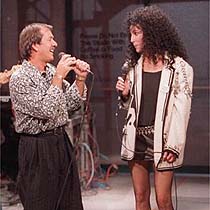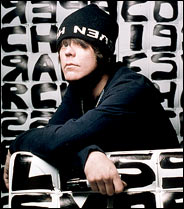Stephen Sprouse, Design Pioneer, Dies at 50
By WILLIAM NORWICH
Published: March 5, 2004
Stephen Sprouse, the American fashion designer and artist who in the early 1980's pioneered that decade's revolutionary idea of mixing uptown sophistication in clothing with a downtown punk and pop sensibility, died yesterday morning at St. Luke's-Roosevelt Hospital Center. He was 50.
The cause was heart failure, said his mother, Joanne Sprouse. She said that lung cancer had been diagnosed about a year ago, but Mr. Sprouse had kept the condition private while continuing to work.
When Mr. Sprouse's approach came into vogue, New York's uptown and downtown worlds, certainly in terms of the city's fashion and society tastes, were divided as if by an invisible Mason-Dixon line: 14th Street.
"Stephen's style was a sort of punk couture," said Simon Doonan, the creative director of Barneys New York. "Europe had Jean-Paul Gaultier, but American fashion had no one like that until Stephen exploded on the scene in a blaze of pop art fluorescence. He opened his store in SoHo when it was considered a dangerous, edgy place. As people uptown began to discover Stephen, they discovered SoHo and it became a fashion destination."
Mr. Sprouse's own punkish look of a sort of deluxe dishevelment — he served guests his famous Bloody Marys in measuring cups and his address book consisted of writing phone numbers on his arms with his ever-handy felt marker — inspired its own following among the poetically fashion-inclined. His early statement as a designer came in a declaration of new clothes that were perfect for a rock star with a secret penchant for good schools and Park Avenue friends.
There were Day-Glo colors, all-black palettes, mirrored sequins, high-tech fabrics and Velcro attachments long before Velcro was a discount fixative, always rendered with the finest tailoring. His hand-painted silk tunics with long skirts covered in transparent sequins sold then for $1,000.
"There was nothing ragamuffin, ever, about Stephen; he used Norman Norell's tailor," like so many of the American fashion greats, said Candy Pratts Price, the director of Style.com and a longtime friend of Mr. Sprouse's. "His father took him to New York when he a kid and introduced him to Blass," Ms. Price said.
Actually, Mr. Sprouse was born in Ohio. His family moved to Indiana, where Mr. Sprouse started designing clothes when he was 9.
"My father, who was in the Air Force, thought my designing was great," Mr. Sprouse told John Duka, reporting in The New York Times in 1983.
"When I was 12 he took me to New York to meet Bill Blass, Geoffrey Beene and Norman Norell. Blass said I could work for him when I got older."
By the time he was 14, Mr. Sprouse was sketching for Blass in the summer. At 18, he attended the Rhode Island School of Design, but stayed for three months. A friend introduced him to Halston.
After three years of working for the designer, Mr. Sprouse left New York, returned in 1974, and photographed rock groups. In 1975, he moved to the Bowery and started designing clothes for Debbie Harry of the rock group Blondie.
With a loan from his family, Mr. Sprouse opened his business in 1983. Although he was always a creative success, business success on the global level never quite came despite the various associations Mr. Sprouse entered into over the years.
"But Stephen's attitude was, well, he didn't care," said a close friend, Nuala Boylan, an art dealer. "If they liked it, great. If they didn't, just never mind."
Most recently, in addition to creating signature graffiti bags for Louis Vuitton, as well as projects for Diesel jeans and fabric for Knoll International, Mr. Sprouse was devoting his time to painting, mostly portraits, Ms. Boylan said. He also was the fashion consultant for the Rock and Roll Hall of Fame Museum in Cleveland.



 i've spoken to him...he's the quietest, nicest guy...wow... i think the eighties art scene is now officially dead ...he was the last one left from it...
i've spoken to him...he's the quietest, nicest guy...wow... i think the eighties art scene is now officially dead ...he was the last one left from it...  he wasnt that old.. how sad
he wasnt that old.. how sad






